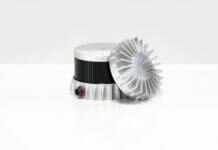Menlo Park, Calif.-based InVisage Technologies Inc., developer of the QuantumFilm camera sensors, has launched its Spark Micro-LiDAR (SML20) module, which enables autonomous drone flight, depth mapping, high-resolution 4K video and obstacle avoidance, according to the company.
The previously announced Spark4K 13-megapixel, 1.1-micron NIR sensor enables the SML20 module to sense structured light patterns with high acuity at a range of 20 meters, even in direct sunlight. This means drones can now self-navigate at a much higher speed, says InVisage.
With a sensor module of just 8.5 x 8.5 x 4.5 millimeters, SML20 is ultra-light, compact and low-power – making the technology ideal for drones and other autonomous devices that require a lighter, more power-efficient alternative to conventional LiDAR (without the limitations of ultrasonic and stereo-camera depth sensing systems).
“In order to perform autonomously at a high flight speed of 20 meters per second, drones and other unmanned vehicles require at least half a second to recognize an upcoming obstacle and another half a second to change trajectory or decelerate in order to avoid it,” says Jess Lee, president and CEO of InVisage. “This means accurate ranging at 20 meters is crucial. SML20 is the only solution enabling obstacle avoidance at that distance without being weighed down by a traditional bulky LiDAR.”
By pairing Spark NIR sensors with lasers emitting a specific pattern of light, users can capture depth maps by detecting modifications to that pattern. SML20 delivers QuantumFilm’s increased sensitivity to 940-nanometer NIR light (five times that of silicon) at a 1.1-micron pixel size. This allows autonomous devices to perceive their surroundings with an accurate depth map fused with the sharpness of 4K 30fps video – in contrast to the limited information in the series of dotted outlines offered by LiDAR, explains InVisage.
Optimized for the invisible NIR 940-nanometer wavelength, SML20 also takes advantage of the fact that water in the atmosphere absorbs most of the 940-nanometer infrared light in sunlight, thus minimizing solar interference with structured light systems.
In addition, SML20’s 1.1-micron pixels have a global electronic shutter, which allows all parts of an image to be captured simultaneously and thus eliminates the distortion of fast-moving objects, the company says.









